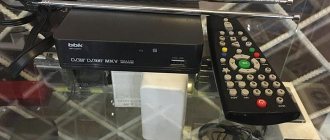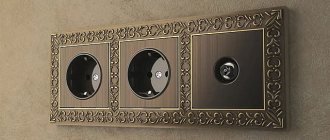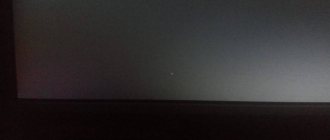Timing controller includes
- Processor for processing LVDS input data pipelines into independent R, G, B pipelines and clock signals for horizontal and vertical matrix drivers. The processor exchanges information with RAM and Eeprom ROM. A fixed supply voltage of 5 or 12 volts supplied from the motherboard is converted into several secondary voltages necessary for the operation of the controller using DC/DC converters.
- Reference voltage generator for DAC drivers that provide the necessary curvature of the image histogram. Otherwise, this process is called gamma correction.
- The voltage generation unit for powering the drivers, usually made on a PWM controller and a key field-effect transistor.
T-con diagnostics and repair
Diagnosing a malfunction in a timing controller can sometimes be extremely difficult. The fact is that the connection of this block with the main board and the LCD matrix is so great that it is sometimes not possible to visually determine what is the source of the defect. Only measurements at T-con control points can indirectly indicate its inoperability. When repairing a matrix controller yourself, you need to have a large amount of information, which the Internet can provide with a careful and painstaking search. The controller itself is considered an integral part of the LCD panel, and manufacturers do not provide electrical diagrams for this unit. This situation forces the teleworker, when repairing this unit, to be guided primarily by his professional instincts and experience in similar repairs. If your TV begins to show a low-contrast, negative, whitish image with moire of various shades in light or dark areas of the picture, there is a high probability that the matrix controller unit is not working correctly. To exclude the influence of the motherboard and carry out diagnostics, many manufacturers of LCD matrices provide for switching T-con into offline mode. In this case, the cable connecting these boards is removed, only the supply voltage is supplied to the controller, and the panel is entered into test mode by closing the service contacts. If the LCD panel and timing controller are working properly, the panel’s self-diagnosis is observed on the screen in the form of alternating colored fields and stripes, as from a television test signal generator. Each type of LCD panel has its own method of entering test mode.
To eliminate the influence of the LCD panel on the matrix controller when measuring the supply voltage of the drivers or the reference voltages for the DAC drivers, use a short-term disconnection of the cables, one or two, on the LCD panel. Based on the nature of changes in instrument readings and the visual perception of the image on the screen, one can draw certain conclusions about the causes of the malfunction. To reliably monitor the performance of a unit when taking measurements, it is necessary to control the presence, shape, amplitude, frequency and duty cycle of pulses, which can be done using an oscilloscope. The presence of an oscilloscope makes it easier to find a defect and is always used for diagnostics in a stationary service center.
In some cases, doubt about the serviceability of the matrix controller occurs due to the absence of an image when the monitor screen is dark or very light (white). It is necessary to control the passage of supply voltage from the main board and the formation of secondary voltages by DC/DC converters in the unit itself. Sometimes problems with the timing controller, and even with the matrix itself, can arise due to the owner being too careful, wiping the TV screen with a too damp cloth, or, conversely, being careless, spilling liquid on the LCD panel or inside the device. If moisture gets on the matrix, irreparable consequences can occur in the form of destruction of current-carrying cables, their corrosion, short-circuiting of drivers and failure of the matrix controller due to a critical violation of its operating mode. Repair of the timing controller is not provided by the manufacturer of the LCD matrices, only its replacement. Therefore, technical information on restoring the block is not provided and there are no diagrams for it. However, in our workshop it is used at the component level without replacing blocks and boards. During restoration, technical information is used in the form of “datasheets” - descriptions, characteristics, connection diagrams of components included in the controller, which allows the TV technician to successfully carry out repair work on such a complex unit of a modern TV as T-con.
Signs and causes of failure
Despite the high reliability of the matrix, it can also fail (like any other component of the TV). Among the reasons leading to its breakdown, the most common are:
- mechanical impacts resulting in damaged or broken screen;
- failure of drivers responsible for image formation;
- damage to the flexible cable.
Repairing a failed matrix is usually impossible. It is possible to restore its functionality only in the case when the defect is associated with a malfunction of the backlight elements of LCD screens - fluorescent lamps (LCD) or LEDs . Such defects are characterized by a complete absence of an image. In some models of LCD TVs (Thompson, Sharp, etc.), these elements can be replaced. At the same time, for different types of television receivers (Dexp, Akai, Supra, Daewoo, etc.), the methods for replacing lamps may differ - in some cases it is necessary to dismantle the matrix, and sometimes you can do without it.
LED
Note! LCD TVs from Toshiba, Philips and some other brands have multiple light sources, so when repairing, you need to check each of them separately.
The fact that the matrix has failed can be determined not only by the complete or partial absence of an image, but also by:
- colored vertical floors instead of video images;
- black circles;
- stains and drips;
- thin horizontal lines;
- dark and light points that do not disappear anywhere.
LCD matrix. Operating principle of a liquid crystal panel.
The “heart” of any liquid crystal monitor is the LCD matrix (Liquid Cristall Display). The LCD panel is a complex multilayer structure. A simplified diagram of a color TFT LCD panel is shown in Fig. 2.
The operating principle of any liquid crystal screen is based on the property of liquid crystals to change (rotate) the plane of polarization of light passing through them in proportion to the voltage applied to them. If a polarizing filter (polarizer) is placed in the path of polarized light passing through liquid crystals, then by changing the voltage applied to the liquid crystals, you can control the amount of light transmitted by the polarizing filter. If the angle between the planes of polarization of the light passing through the liquid crystals and the light filter is 0 degrees, then the light will pass through the polarizer without loss (maximum transparency), if it is 90 degrees, then the light filter will transmit a minimum amount of light (minimum transparency).
| Operating principle of LCD panel |
Fig.1. LCD monitor. Operating principle of LCD technology.
Thus, using liquid crystals, it is possible to produce optical elements with a variable degree of transparency. In this case, the level of light transmission of such an element depends on the voltage applied to it. Any LCD screen on a computer monitor, laptop, tablet or TV contains from several hundred thousand to several million of these cells, fractions of a millimeter in size. They are combined into an LCD matrix and with their help we can form an image on the surface of a liquid crystal screen.
Liquid crystals were discovered at the end of the 19th century. However, the first display devices based on them appeared only in the late 60s of the 20th century. The first attempts to use LCD screens in computers were made in the eighties of the last century. The first liquid crystal monitors were monochrome and were much inferior in image quality to cathode ray tube (CRT) displays. The main disadvantages of the first generations of LCD monitors were:
- - low performance and image inertia;
- — “tails” and “shadows” in the image from the elements of the picture;
- - poor image resolution;
- — black and white or color image with low color depth;
- - and so on.
However, progress did not stand still and, over time, new materials and technologies were developed in the manufacture of liquid crystal monitors. Advances in microelectronics technology and the development of new substances with liquid crystal properties have significantly improved the performance of LCD monitors.
When to contact specialists
In some cases, it is not possible to repair or replace TV components yourself. The optimal solution to the problem in such situations is to seek professional help from official service centers and private workshops. It is recommended to use the services of specialists if:
- the screen is severely damaged and the internal components of the device are affected;
- there is no practical experience in repairs and confidence in the correct execution of repairs;
- replacement requires rare parts that cannot be found in electronics stores on your own;
- A repair attempt was made, but it was not possible to restore the display.
Repairing a TV in service centers will cost more than fixing it yourself, but turning to specialists has several advantages.
The main advantage is the high probability of successful repair and preliminary performance of complex diagnostics using specialized equipment. Another advantage of professional repair is the quick selection of the necessary components and prompt repairs with a quality guarantee.
This is interesting: The machine knocks out when you turn on the washing machine: causes of malfunction, expert advice
Design and operation of TFT LCD matrix.
One of the main achievements was the invention of LCD TFT matrix technology - liquid crystal matrix with thin film transistors (Thin Film Transistors). TFT monitors have dramatically increased pixel speed, increased image color depth, and managed to get rid of “tails” and “shadows.” The structure of the panel manufactured using TFT technology is shown in Fig. 2
| LCD panel structure |
Fig.2. TFT LCD matrix structure diagram. A full-color image on an LCD matrix is formed from individual dots (pixels), each of which usually consists of three elements (subpixels) responsible for the brightness of each of the main components of color - usually red ®, green (G) and blue (B) - RGB . The monitor's video system continuously scans all subpixels of the matrix, recording a charge level proportional to the brightness of each subpixel into the storage capacitors. Thin Film Transistors (Thin Film Trasistor (TFT) - in fact, that’s why the TFT matrix is called that) connect storage capacitors to the data bus at the time information is written to a given subpixel and switch the storage capacitor to charge conservation mode for the rest of the time.
The voltage stored in the memory capacitor of the TFT matrix acts on the liquid crystals of a given subpixel, rotating the plane of polarization of light passing through them from the backlight by an angle proportional to this voltage. Having passed through a cell with liquid crystals, the light enters a matrix light filter, on which a light filter of one of the primary colors (RGB) is formed for each subpixel. The pattern of the relative positions of dots of different colors is different for each type of LCD panel, but this is a separate topic. Next, the generated light flux of primary colors enters an external polarizing filter, the light transmittance of which depends on the polarization angle of the light wave incident on it.
A polarizing filter is transparent to those light waves whose plane of polarization is parallel to its own plane of polarization. As this angle increases, the polarizing filter begins to transmit less and less light, up to a maximum attenuation at an angle of 90 degrees. Ideally, a polarizing filter should not transmit light polarized orthogonally to its own plane of polarization, but in real life, a small portion of the light does pass through. Therefore, all LCD displays have insufficient black depth, which is especially pronounced at high backlight brightness levels.
As a result, in an LCD display, the light flux from some subpixels passes through a polarizing filter without loss, from other subpixels it is attenuated by a certain amount, and from some subpixels it is almost completely absorbed. Thus, by adjusting the level of each primary color in individual subpixels, it is possible to obtain a pixel of any color shade from them. And from many colored pixels, create a full-screen color image.
The LCD monitor made it possible to make a major breakthrough in computer technology, making it accessible to a large number of people. Moreover, without an LCD screen it would be impossible to create portable computers such as laptops and netbooks, tablets and cell phones. But is everything so rosy with the use of liquid crystal displays?
DIY LCD monitor repair
A common malfunction is when the LCD monitor lights up for a second and goes out. What to do in this case and how to use this TOP of faults.
It's simple. To repair your LCD monitor, follow these steps:
- Step 1. Disconnect the monitor from the 220 V network and from the computer and decide whether we will repair it ourselves or take it to a service center for diagnostics at an inexpensive price.
- Step 2. If you decide to figure it out yourself, then take the tools: screwdrivers, a knife or scalpel and a soft base to lay the monitor down with the matrix.
- Step 3. Disassemble the LCD display, observing safety precautions and remembering the latches. How they open is shown in the animation above.
- Step 4. Discharge the high voltage capacitor. It is necessary! Especially if you want to achieve a positive result of the repair.
- Step 5. Inspect the board for swollen capacitors, burnt transistors and microcracks.
- Step 6. If any findings are found in Step 5, replace the burnt ones and solder the cracked ones.
- Step 7. Check the functionality of the monitor, observing safety precautions. If everything is ok, then go to Step 10.
- Step 8. Take a multimeter and test the fuses, diode bridge, transformers and transistors. Replace burnt radio elements.
- Step 9. Check the operation of the LCD monitor. If the monitor continues to blink, check the voltage at the test points on the board. This requires knowledge of circuit design, as well as a service manual with an ideal circuit. Further actions are difficult to describe in general terms. This is where the creative process of the Repairman begins. To discuss, write in the comments or contact.
- Step 10: If you successfully repair the flickering LCD monitor yourself, do a test run for 2-3 hours in a disassembled state. After this, the monitor can be assembled and used.
What is a pixel on a TV?
Creating an LCD panel is a very complex process and there are many technologies for reproducing information based on liquid crystals. Liquid crystal displays are used in almost all digital devices (computers, televisions, cameras, phones, navigators...) and nowadays life without them is unthinkable. All these digital devices with LCD technology have become firmly established in our lives, and with them a problem of paramount importance has entered our lives - dead pixels.
LCD technology is based on liquid crystals through which light is passed to produce an image. Most often, the outer layers of an LCD panel are made of glass, and between them and the polarizing filters a thin-film transistor, a color filter panel, and a layer of liquid crystals with a standard backlight module inside (back, side...) are placed. While the TV is operating, light passes through a layer of liquid crystals and the viewer sees an image of pixels painted in different colors.
Each pixel consists of three subpixels (red, green and blue) with which the liquid crystal display is capable of distinguishing millions of colors and shades. Molecules of liquid crystals behave like molecules of a liquid substance, being constantly in motion, but as befits crystals, their orientation remains unchanged. The orientation changes only under the influence of an electric field.
A pixel is the smallest element of a digital image or display matrix, which is an indivisible rectangular or round object that forms an image on the screen.
As soon as this condition begins to be met, the substance in the form of liquid crystals begins to change orientation, up to a selective change in subpixel. Crystals here play the role of optical lenses that change the polarization of light waves. Each pixel in a liquid crystal panel works on this principle.
Can it be repaired?
LCD TVs have become widespread and are installed in many apartments. The popularity of the devices is due to the high-quality images that are suitable for viewing modern content. When wondering whether an LCD display can be repaired, you need to conduct diagnostics and understand the nuances of the TV’s operation.
The main component of the screen is a matrix containing a large number of particles filled with a mixture of xenon and neon. Semiconductors are located along the perimeter of the matrix. During operation of the device, electricity passes through the gaseous medium and produces ultraviolet light, which illuminates the phosphors. Due to this process, individual cells are highlighted in different colors.
All display components are located in a compact space between the planes, which are made from a special type of glass.
When diagnosing a TV screen, you need to determine the type of damage. The most common breakdowns are the following:
- the formation of severe defects provoked by external mechanical influence;
- disruption of the transmitted image due to liquid ingress;
- the occurrence of scratches and microcracks on the surface of the display.
If the screen is severely damaged and the integrity of the matrix is compromised, the gas mixture will begin to escape, and it will be impossible to repair the device. The only way out in this situation is to purchase and replace the matrix. Since the cost of a new matrix is high and comparable to prices for televisions, you should immediately consider purchasing a new device.
Small scratches that do not affect the condition of the matrix can be eliminated yourself. To do this, wipe the surface with a weakly concentrated solution of ethyl alcohol or a special product intended for liquid crystal monitors.
Causes of dead pixels.
Modern TVs usually use an active matrix, and the number of pixels in liquid crystal displays is simply huge and it is simply impossible to guarantee the serviceability of each of them. In order for a dead pixel to appear on a TV, it is enough that the control transistor fails or the subpixel gets stuck in one position.
In the first case, it will not be possible to restore black dead pixels (non-working transistor) on your own, without the appropriate skills and equipment. I once read that in factory conditions you can simply burn out a damaged transistor using a laser. Of course, it will not be possible to return such a pixel to working condition, but it will be less noticeable to the human eye. I don’t know how true this is... Perhaps there is another more affordable solution for restoring this type of dead pixel, but I think that such a defective pixel cannot be “cured”. This type of dead pixel appears as a black dot and will be especially visible on a screen with a white or light background.
In the second case, the defect of a dead pixel can be eliminated using software or through physical manipulation at home. This dead pixel defect is called a “stuck pixel” and appears as a light or colored dot on the screen. This is caused by the fact that the subpixel is stuck in one of the positions and glows in one color on the display. I will tell you further how to remove such dead pixels. By the way, sometimes dead pixels that appear can disappear after a while.
The causes of dead pixels can be either a manufacturing defect or imperfect technology. Yes, dear reader, nothing is perfect in this world. It must be said that there are standards regulating the number of permissible matrix defects (dead pixels) in the presence of which a digital device will not be considered defective. This means you won’t be able to return it to the store under warranty or as defective. Therefore, be sure to test your TV for dead pixels when purchasing.
Prevention
If the malfunction of the television receiver matrix is not associated with a manufacturing defect or natural wear of parts, then in some cases this problem can be prevented.
- Equipment should be protected from mechanical impact: shocks, falls, and so on. It must be remembered that the screen is highly fragile.
- It is necessary to exclude any exposure to moisture, since it destroys the electrodes, breaks the contacts and, as a result, causes problems with the image.
- It is recommended to connect the television receiver to the mains through a stabilizer. This way you can avoid malfunctions of the chips that form the video image and the cable, which in some cases can be caused by frequent voltage surges, lightning strikes and similar electrical phenomena.
Advice! To further prevent damage to the matrix, it is advisable to additionally purchase a protective transparent screen. This is especially true for owners of plasma panels.
So, damage to the matrix is a very unpleasant event. Replacing it in a workshop is an expensive repair job, but it is still recommended to entrust this process to professionals. However, you can change a failed element yourself at home, but only if you have skills in fine electrical work.
Allowable number of dead pixels.
The permissible number of dead pixels on a liquid crystal matrix is determined using a special specification ISO 13406-2 (in Russia - GOST R 52324-2005). It should be said that this document contains about 150 pages and regulates not only defective pixels, but also defines a number of other requirements such as the degree of reflection, brightness and contrast levels, text readability, fill factor, uniformity of backlight and color fills, flicker and glare...
Nowadays, all famous brands and manufacturers adhere to the ISO 13406-2 standard, because creating a liquid crystal matrix is a very expensive and labor-intensive process, and the assembled panel can only be tested for defective pixels after complete production. In this regard, manufacturers try to reject such products as little as possible, assigning them after testing to one of four quality classes. The ISO 13406-2 specification itself defines four classes (class I, class II, class III or class IV).
Less significant problems
Also, problems with the LCD monitor can arise due to the following breakdowns:
- Antenna and receiver - in this case the screen is fully operational, the problem is in the additional equipment. In some cases, you just need to tighten the contact or reconfigure the antenna, and the interference and problems will be eliminated.
- The cooling system is a common problem with LCD monitors; it can be fixed with the help of specialists, but DIY repairs are also possible.
- Video processor – if the video processor fails, stripes appear on the screen. Before repairs, diagnostics are usually carried out using special equipment.
What is a television matrix?
The matrix in a TV is a system of thin conductors superimposed on each other in the form of a grid. From the inside it is filled with liquid crystals, to which voltage is applied using electrodes (conductors). Under the influence of an electric charge, the crystals acquire a certain color, due to which a bright, clear and colorful image appears on the TV screen.
Modern manufacturers of household appliances use various types of elements that differ in manufacturing technology and operating features. Most often, the following three types of matrices are used in liquid crystal (LCD) TVs:
| Type | Advantages | Flaws |
| TN | Low cost, low energy consumption | Small viewing angles, relatively short service life |
| IPS | Large viewing angles, high image quality, comfortable and eye-safe radiation levels | High cost, poor black color, insufficient contrast |
| V.A. | Rich black color, good color rendering, optimal price-quality ratio | Insufficient brightness (compared to IPS) |
TN matrices are most susceptible to breakdowns - “broken” pixels appear on them, the picture bifurcates. But the owner of any TV can encounter a low-quality image, regardless of the installed components.
Causes of malfunction
The matrix is responsible for displaying the image on the screen and is one of the main elements of LCD TVs. Manufacturers pay great attention to the quality of this unit: if the operating rules are followed, it can last 10-15 years without losing the brightness, clarity and contrast of the image.
Most often, the following factors lead to the malfunction of this element:
- A strong blow to the screen breaks the integrity of the conductors.
- Water ingress causes a short circuit, as a result of which individual electrodes lose functionality.
- Factory defects - poor quality assembly usually appears a month or two after purchasing the equipment.
If there is no visible damage, the exact cause of the malfunction can only be determined after service diagnostics.
How to choose a new screen
If it is necessary to replace the LCD TV screen, a new component is selected taking into account several criteria. In particular, it is important to consider:
- Screen dimensions. Before replacing the matrix, measure the length and width of the part being replaced. Otherwise, installation will not be possible.
- Quality of the transmitted image. Manufacturers offer a large number of matrices, which differ in the number of phosphors. Depending on the maximum screen resolution, the picture quality increases.
- Price. As a rule, new TV screens are sold at inflated prices, so repairs are not always advisable.
How is the connection between the cable and the matrix arranged?
Below are different diagrams that convey one idea - it is used to connect the contacts of a flexible cable with the sprayed contacts of the matrix. Inside this tape (in my opinion) there are conductive beads located at a sufficient distance between each other so that there is no electrical contact. Contact appears when the tape is heated and compressed - the balls come closer and conductivity appears.
It must be remembered that a decoder is placed on the flexible cable and the problem may be at the junction of the cable and the decoder.
What does the screen consist of?
The main component is the matrix. It contains a huge number of particles that are filled with xenon and neon. The matrix is framed around the perimeter with semiconductors. Phosphors begin to glow when UV is created - a glow created by an electric current that passes through a gas medium. This process causes the cell to glow in the desired color. Together, tens of hundreds of cells create the image that the TV shows.
What to do with a cracked TV screen? please advise!
The entire screen structure is located in a small space between two planes, which are made of durable glass. To understand whether the LCD screen is broken, you need to understand how the breakdown occurred.
Damage to the cable and glass leads to the need to completely change the matrix.
Disassembling the device and fixing the problem
It is very important to carry out the disassembly procedure very carefully so as not to damage other components of the device and not make TV repair prohibitively expensive. It is especially important to be careful when removing the screen itself, because breaking the cable leading to it will require, as in the case of physical destruction, a complete replacement of the matrix.
Alas, such repairs cannot always be called a profitable solution, because taking into account its cost, it would be much more reasonable to purchase a new model. The exact price depends on the features of the matrix, the presence of other defects, as well as the availability of a new screen for sale.
Before disassembling the TV, you need to prepare enough space on a large table. The space should be at least 2.5-3 times larger than the dimensions of the device. This is necessary for conveniently rearranging different elements, such as screws, boards, as well as the matrix itself. It is also recommended to place a piece of cardboard or thick soft cloth on the place where all procedures will be carried out, which will protect the display from scratches, chips and other damage.
Then the TV is placed on the table with the screen down and the screws holding the cover are unscrewed around the perimeter of the case. After this, it should be easy to remove, but sometimes you will also need to find an additional lock and set it in a different position. After completing this procedure, turn the TV over and remove the front frame from the latches, which will help you gain access to the matrix. In some cases, you can access the insides of the TV not from the back, but from the front, which depends on the design of the device.
If you accidentally spilled a drink (coffee, soda, etc.) on the TV, after which image artifacts appeared on the screen, then sometimes to restore the TV’s functionality it is enough to clean the cables leading to the display. In this case, in addition to screwdrivers for disassembly, you only need a regular eraser. However, this method will not help with physical damage.
Conclusion
Self-repairing the LCD matrix of a TV is a fairly simple procedure, in which the most important thing is not previously acquired skills, but caution and strict adherence to instructions. If you have minimal experience in disassembling equipment, then you can replace the screen on your TV without any problems. But for more serious damage, you should make sure that you are able to fix the identified problem, and also make sure that such repairs are advisable. Some types of damage will cost TV owners 60-80% of the cost of a brand new model, so evaluate the economic benefit. If, from a financial point of view, repair does not seem an attractive solution, then you should take the TV to a workshop for spare parts, earning some money for it.
Replacing the matrix
When the case is completely removed, you will see in front of you a metal matrix frame on which all the electronics and cables connected to them are attached.
The latter must be disconnected very carefully to prevent breakage. Replacing the LCD matrix on a TV is a fragile process. Then unscrew all the screws that secure the motherboard, power supply and other components.
Advice! In order not to get confused in the subsequent assembly, you can first photograph the placement of all elements of the TV.
After all the components of the model are disconnected from the matrix, you need to unpack the new screen and attach all the boards, cables and speakers to it in the reverse order. Once all the modules are in place, you can begin installing the frame and cover in place, as well as subsequently checking the functionality of the device.
Expert advice
- If there are vertical thin stripes, it is worth checking not only the matrix, but also the video amplifier and color block;
- Lamps in the matrix may burn out due to power surges. They are being replaced;
- Matrix repair makes sense only if the price of a new TV is higher than the part;
- The body of the equipment is assembled in the opposite direction;
- Some cables can only be removed by lifting the clamping bar;
- If the TV's warranty is still valid, but the matrix is broken, take it to a service center for repair.
Watch a video on how to dismantle the matrix of a large diagonal TV
Diagnosis of LED backlight malfunction
We will start repairing the LED backlight of the LG TV matrix by preparing the workplace, since when disassembling the TV we will need a separate table on which we will arrange such fragile parts as the matrix and light filters. I always repair such TVs with trepidation, since one wrong move can send the matrix to scrap.
Having laid the TV down, I unscrewed all the bolts around the perimeter of the cover.
TV after disassembly
Having removed the cover, I decided to measure the voltage on the LED driver at the moment it was turned on.
Connector for LEDs
At the moment of switching on, the voltage rose to 130 volts, after which it slowly dropped to zero. This behavior of the driver is normal, since if there is no load, it goes into protection and turns off the power.
PS: How to disassemble the monitor and TV (how to unclip the frame)
The most common questions when disassembling LCD monitors and TVs are how to remove the frame? How to release the latches? How to remove the plastic case? etc.
One of the craftsmen made a good animation explaining how to remove the latches from engagement with the body, so I’ll leave it here - it will come in handy.
To view the animation , click on the image.
Complete disassembly of the TV. Step-by-step instruction
Having confirmed that it was the backlight that was faulty, I proceeded to completely disassemble the TV.
First, I disconnected the cables going to the T-CON board and the MAIN board, then unscrewed and removed these boards.
Disabling the loop to the T-CON board
Power supply and MAIN boards removed
Removing the protection of the T-CON board
There were no problems with the T-CON board either. Carefully snapped the cables that went to the matrix decoders and removed the T-CON board.
Disabling T-CON board loops
The cables are disconnected and the board is removed
Next, I unscrewed the bolts that held the protection of the matrix decoder, after which I removed it and put it aside.
Removing the decoder protection bar
NEXT WE DO EVERYTHING VERY AND VERY CAREFULLY!!!
- We turn the case over with the matrix facing up, and then carefully snap off the front metal frame.
We snap off these latches around the perimeter. If something cannot be removed immediately, under no circumstances do we use force. We take a good look at all the fasteners, look for the interfering latch, and only then remove the frame. - After removing the frame, it is necessary to release the decoders from the rubber holders.
The decoders have not yet been removed from the latches.
We also do this very carefully, first we release the lower part of the decoder, after which it should hang on the cable without any effort.
Decoders removed from latches - I removed the matrix along with the plastic frame. Since the frame sits tightly on the latches, I cut squares from the remains of thin plastic and inserted them under the latch, between the plastic part and the metal part, thereby freeing all the latches around the perimeter.
- After this, the frame along with the matrix was completely removed. It is necessary to place the removed matrix in a previously prepared place, while paying special attention to the cables so that they are not damaged in any way.
- After removing the frame, remove the films. We do this simply, move it to the bottommost layer (there is a layer like an org. stele), and remove it from the TV.
We got to the LEDs - Now you need to remove the reflective film. It is held on with the help of supporting clips.
We pry up the clip
The clip has been removed
This completes the disassembly.
Replacing a cracked display yourself
If you decide to fix the problem yourself, use the general recommendations. Please read the device installation instructions first. So, how to replace:
- Disconnect the TV from the power supply, remove all cables from the outside;
- place the device on a soft and flat surface;
- unscrew the screws;
- remove the frame on the damaged screen;
- remove cables and wires from the inside, remove the screen;
- mount the new panel and connect cables and wires. Turn on the power.
As you can see, it’s not difficult to do everything yourself. The main thing is that changing the screen does not cost you more than buying a new plasma.










